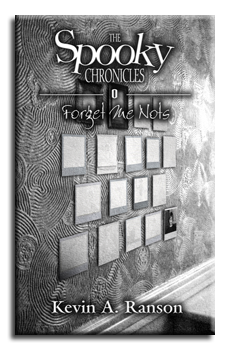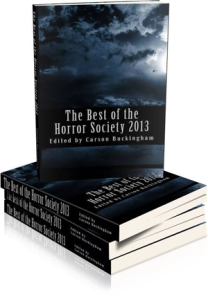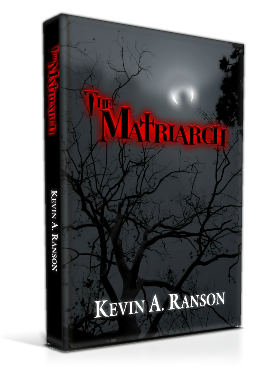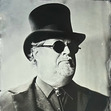Kevin A. Ranson's Blog, page 11
February 16, 2014
Read “Forget Me Nots” for FREE… Right Now!
The Spooky Chronicles: Forget Me Nots
Read it for FREE – right here, right now on your browser!
Andres M. (Rating: 4 of 5 Stars) – I had my reservations… (an) undead kid who goes to school and stuff? I must confess that I was a little skeptical of how that could work. I was terribly mistaken. Yes, this story is about a young kid with an unique condition, his heart doesn’t beat, his blood doesn’t flow, and his lungs don’t breath; yep, he is an undead, but with a soul, conscience, and a spirit of adventure and investigation. We are taken to a Lovecraftian story, and we experience it from the view point of a very special kid, who is eager to “see” what’s beyond, the monsters, the horrors. All and all it was a very cool story.

The prequel to The Spooky Chronicles!
There’s something sinister about Chesterfield Mansion, and “Spooky” Spencer Lawson can’t wait to find out why. Locked inside on a stormy night, Spooky and his fellow fifth graders are tasked to find thirteen skeleton keys before the stroke of midnight, but their host and his trusted minions are secretly watching for one of those children… the one who won’t be missed.
eBook ISBN: 978-1-4762-6296-3
Purchase eBook for Download:
Amazon Kindle
Apple iPad, iPhone, iPod Touch
Barnes & Nobles Nook
Diesel eBook Store
DriveThruFiction (pdf)
Smashwords (mobi, epub, pdf)
Filed under: Critiquery, Horrificus, Literarian, Paranormal Tagged: book, bookgiveaway, boy, chronicles, horror, middle school, mustread, mystery, novella, Occult, Paranormal, Series, spooky, teen reading, undead, YA, zombie


February 12, 2014
Self-Editing Techniques (Before Submitting to an Editor)
 Editors are expensive, but the more you edit yourself, the better you’ll become. Knowing the grammar rules and how to apply them is part of the process; the rest is actually finding the errors in your own work. The more mistakes that you find and correct yourself, the easier of a time your actual editors will have finding the things you’ll STILL miss.
Editors are expensive, but the more you edit yourself, the better you’ll become. Knowing the grammar rules and how to apply them is part of the process; the rest is actually finding the errors in your own work. The more mistakes that you find and correct yourself, the easier of a time your actual editors will have finding the things you’ll STILL miss.
Set it aside for a few days for a fresh look – Looking over the same pages, paragraphs and sentences over and over has a peculiar effect on the brain: you’ll start filling in words that aren’t there. Close the book, go do or work on something else, then look over it again and NOT on the same day. If you can wait a week or longer, even better.
Change the font face and text size – A special thanks to Gabrielle Faust for this suggestion! Changing the font up does a couple of things: it makes everything look different as if you’re reading it for the first time (again), including pushing words to different lines to break up the familiar cadence. This helps obvious mistakes stand out.
Edit chapters from the back to the front – Another good way to catch continuity errors is to start at the end and work your way forward. This helps train your brain to wonder how you got to where you ended up; did you forget any important details earlier in the text that would make your story read or flow better?
Let Adobe Reader read it to you – This is one of my best tricks for catching bad phrasing, double words, missing words and more. Compile your manuscript into a PDF and open it with a free copy of Adobe Reader, then select the “Read out loud” option under “View.” A dull and boring computerized voice will read your book to you paragraph by paragraph without anything resembling inflection, but it hearing it out loud rather than reading it again to yourself helps to find lots of glossed-over errors your brain omits.
Remember: many eyes make for easy editing. Different readers will catch different mistakes, so if you have a trusted beta reader with both kick-ass grammar skills and a willingness to read your entire book, take them up on it. Never, never, NEVER reply solely upon your own judgement that the editing is done and the book is perfect – I promise you… you’re wrong.
Does anyone else have any other trick that they use? Add them below!
Filed under: Creativity, Literarian Tagged: editor, Self-Editing, Submitting, Techniques


February 5, 2014
Less Is More: Creating a Vampire World
I just wrote a piece over on Vamped.org about my take on vampires. Here’s a bit:
One issue I’ve noticed in a lot of paranormal fiction is scale: getting too big too fast.
All the vampires have a werewolf bodyguard, legions of angels are waiting behind every storm cloud, and the sewers are bursting with more vampires than rats.
In these kinds of stories, it’s almost a given that the protagonist will catch the eye of someone too big for them to handle, setting up a final confrontation with world-changing ramifications. To quote Riley from Buffy the Vampire Slayer, “I suddenly find myself needing to know the plural of apocalypse.”
I offer a different viewpoint: less is more.
Read the rest over at Vamped.org!
Filed under: Creativity, Existentialism, Hollywood, Literarian, Paranormal Tagged: creating, less is more, vampire, world


December 25, 2013
Must the Male Vampire Always Be On Top in Paranormal Romance?
 I’m not saying this is bad – I’m just asking if this is how it has to be.
I’m not saying this is bad – I’m just asking if this is how it has to be.
I am a male writer who tends to write strong female characters in paranormal horror. This isn’t just my opinion (although it is my intent), but I am told by readers that I do. If a heroine is going to step up, I feel they should hold their own; they make the decisions and accept the consequences for their actions. Blechdel Test be damned, females do talk about males, and often there is romantic inclination or outright sex with a male character; hey, it happens.
I enjoy the inherit vampire and horror elements in these stories, but I am noticing a trend in several of these stories, particularly the one billed as “paranormal romance.” The female character – whether merely human or already vampire – appears to be smitten with or otherwise bonded to a superior male specimen. These dude-bros have names like Caleb, Stefano, Morbius, Vlad or something else overly masculine. Head-over-heels attracted to them, the heroine obeys – or is given no choice but to obey – this dominant character in all things despite yearning to be an equal in their eyes. Time doesn’t seem to be a factor; these women often have been kept under thumb or under house arrest for centuries. The smitten female underling, of course, is the main character, and they aren’t only being mentally subjugated but often physically – but no permanent harm done since they’re a vampire, right?
To contrast this, what I am not reading about is an intelligent, handsome young man being kept under the thumb of an ancient vampiress who has strong feelings for the lad but believes him incapable of surviving on his own. In spite of proving himself up to the task or otherwise demonstrating the potential for an equality to their sire/object of infatuation, each scene of the story is a compact lesson in why the dominant female is the alpha, subjugating the omega male to repeated but doomed attempts to measure up time and time again. With no regard to the male character’s secret paranormal lineage, forbidden knowledge of ancient magics, or in any way possessing skills and ability superior to the dominate female vamp, he always crawls on his belly back to the feet of the creature he can’t wait to be dominated by. Oh, and the main character must be HIM, not the alpha vampire mistress.
Does this exist, is this an impossibility or do I need to write this and see just how twisted I can make it?

Filed under: Conspiracies, Creativity, Critiquery, Existentialism, Literarian Tagged: Blechdel Test, female, horror elements, male, Paranormal Romance, vampires


December 22, 2013
Praise for “Tendrils Never Lie” – Thank You!
I like “Tendrils Never Lie” by Kevin A Ranson. It successfully incorporates some classical horror concepts into a very well observed and executed modern setting.
 That blurb is one tiny part of a full anthology review of The Best of The Horror Society 2013 available on Amazon. Someone not only reviewed the book but talked up each story inside; you don’t see that kind of thing very often, so I had to share! Here’s more:
That blurb is one tiny part of a full anthology review of The Best of The Horror Society 2013 available on Amazon. Someone not only reviewed the book but talked up each story inside; you don’t see that kind of thing very often, so I had to share! Here’s more:
There are some very good writers here. Along with the legenary William F. Nolan, the only living writer I know of who can be included along with the likes of Robert Bloch, Richard Matheson and Ray Bradbury. Included too are rising stars Richard Thomas, Weldon Burge, Joe McKInney, Aaron Warwick Dries, Robert S. Wilson, Scott Gorsiak (grin) and editor Carson Buckingham. Twenty-Five Tales of short and not-so-short, high quality and mostly unfamiliar shivers. Authors are included I’ve never heard of, but I chalk that up to personal ignorance on my part. One Hell of a lot of good horror writers have shambled their way into print and eprint over the last few years. It’s enough to make you throw your typewriter against the wall and try writing Harlequin Romances.

Filed under: Creativity, Horrificus, Literarian Tagged: 2013, amazon, Horror Society, Kevin A. Ranson, tendrils never lie


December 19, 2013
New Key Art for The Matriarch: “Janiss in the Graveyard”
In an effort to continue supporting The Matriarch and get the word out, I have begun processing a series of new images which will eventually become the foundation for a new book trailer.

For those of you who’ve read it, is this how you imagined Janiss?
For those of you who have not, is it a compelling image?
More to come!

Filed under: Cemetery, Creativity, Literarian Tagged: graveyard, horror, Janiss, Kevin Ranson, Matrarch, novel, thriller, vampires


November 9, 2013
Reader Review of The Matriarch – “A Highly Original, Enticing Read!”
5.0 out of 5 stars: A Highly Original, Enticing Read!
November 9, 2013 By CLynn
This review is from: The Matriarch (Kindle Edition) verified purchase, Amazon UK
 An unsolved murder…and a surprising revelation that solves the mystery, I liked that.
An unsolved murder…and a surprising revelation that solves the mystery, I liked that.
The heroine was strong, I cared about her. That is so important in a novel. I particularly cared as I witnessed her adjusting to her new existence. The villain was very well done, without being overdone. I found him deliciously savage! And I liked, too that everything was wrapped up nicely with no loose ends.
I really enjoyed the author’s take on vampires. He’s given them very interesting characteristics. The heroine for instance discovers that she will never dream again and I found this very poignant.
I like vampire fiction that depicts vampires as complex characters–where their living lives and their undead existence is developed nicely. It makes for an interesting story.
There are also ghosts and hauntings and surprises too. What more could you ask for?

Filed under: Creativity, Horrificus, Literarian, Paranormal Tagged: ghosts, hauntings, Kevin A. Ranson, Matriarch, murder, novel, vampire


November 6, 2013
Bullying Revisited: Taking Personal Power
I was bullied growing up; I’ve written about it at length.
Go ahead and read it if you haven’t; I’ll wait…
You’re back? Great! I’ve had a few additional thoughts about it since writing it, some of them coming to mind after watching Ender’s Game (good flick, by the way).
First of all, I despise the whole “I don’t want to get in trouble” factor almost as much as I hate the apathetic “I don’t want to get involved” ideal. YOU ARE IN TROUBLE; you’re being picked on. This “punishment avoidance” thing used to be the go-to pre-emptive tactic employed by school administrators; the reason that bullying in school has gone under the radar for so long is because administrators sweep it under the carpet. ANYONE causing a disruption, whether pickee or picker, is held responsible no matter who started it. My most recent Spooky Chronicles book, Greene Square Middle, was absolutely based on the relationship I had with my own Vice Principal in Junior High when I decided to fight back; I told him that if he didn’t do his job to keep me safe, then he’d better get used to seeing me around since I had to do his job for him.
The second is about taking personal power. Feeling powerless is bad enough without without others reminding you of it, but if you have power, even if it isn’t the same as someone else, it’s still empowering. Not everyone can be the sports star or naturally athletic; not everyone can be the prettiest or most attractive. If you want these things, you might be able to achieve them through other means, but it’s more likely you have other talents, things that make you relevant to yourself: you’re NOT worthless.
Maybe you can create art or write. Maybe you can fix engines or design vehicles. Whatever it is, navigating social circles isn’t about letting everyone know who you are and what you can do; it’s the natural presence you exude when you draw on the self-confidence from believing in your own personal power. Others will feel it even if they don’t know what the source of it is, and when everyone has that, they have nothing to pick on you for because that belongs to you and you alone.
Only YOU can allow yourself to feel worthless; never give your personal power away.
P.S. And if you have personal power, don’t abuse it and become what you hate. Remember: with great personal power… yada yada yada. 

Filed under: Conspiracies, Existentialism Tagged: belief, bullies, bullying, feeling powerless, fighting, kids, personal power, school, teachers


October 20, 2013
“The Lucky Five”
—
 Between the passengers and their equipment, six people occupied the space of twelve, almost the capacity of the elevator.
Between the passengers and their equipment, six people occupied the space of twelve, almost the capacity of the elevator.
Five of the riders wore blue gloves and knee-length white coats over scrubs; the sixth wore a dark suit and a wireless earpiece. A lab cart had been assigned to each of the technicians while the man in the suit carried a computer tablet. Everyone looked straight ahead in silence, focused on the task at hand.
The doors opened; the stop switch was pulled. The suited man started a timer on his tablet as the five techs pushed their carts out of the elevator. Of the twenty doors in the long hallway, five had been pre-selected; in concert, the techs knocked and waited while the suited man watched.
One by one, the techs disappeared into the rooms as each door opened. The suited man quietly observed from the hallway so as not to interrupt the collection; time was of the essence.
In the first room, the elderly resident had been watching a movie before pausing it. He surrendered his right arm as the tech prepped his skin and expertly inserted a needle attached to a cup. The resident winced for a moment and relaxed.
Collection was already proceeding in another room. The tech quickly inserted a red-capped glass vial into the needled cup and twisted it to begin the flow of blood. When it was filled, she twisted it out again and replaced it with another. The move was practiced and smooth; the donor smiled at the absence of any discomfort. Once the needle was removed, a sterile gauze pad was taped over the skin as familiar instructions were hastily issued to the donor.
The suited man checked the time as the technicians emerged from their assigned rooms. On each of their carts were ten red-capped glass vials filled with blood, fifty in all. Noting the collection on his tablet, the group headed back to the elevator. Once everyone was inside, the stop switch was depressed to release the elevator; the doors closed.
On the ground floor, the collection carts were pushed into the secured blood lab while the suited man followed. Each of the procured vials were quickly but carefully inserted into a circular tray that held the exact number of samples collected. The tray was pushed beneath a stainless steel apparatus that aligned with each vial simultaneously; a lever raised the tray into the metallic device and locked it into position. Levers on two support arms elevating the apparatus over the table were disengaged, allowing the entire device to be inverted.
Alerted by the beeping from a standard microwave oven, a warmed ceramic cup was withdrawn, black on the outside and white on the interior, the tall kind used in trendy coffee houses. After securing the cup beneath a nozzle, a button was pressed that drained the vials into the waiting cup below, filling it to within half an inch of the top – a perfect pint.
The suited man noted the time on his tablet, nodded in approval to everyone in the lab, and took the cup away with him. In the office he worked out of, he set the cup down on the far edge of his desk and checked to ensure there was no spillage. Satisfied, he sat down and resumed his work, waiting.
Within a few minutes, the executive administrator entered the office. Going right to the cup, she smiled at its warmth as she picked it up.
“It never ceases to amaze me that you have this waiting every time I come in,” she said. “Who are today’s lucky five?”
The suited man looked away from his laptop. “You tell me.”
After flashing him a knowing smile, the administrator lifted the cup to her lips and drank deeply.
Filed under: Cemetery, Conspiracies, Creativity, Existentialism, Horrificus, Literarian, Paranormal Tagged: blood, horror, Matriarch, short story, vampire


October 16, 2013
The Best of The Horror Society 2013 has been published!
 A central coast trip that leads to devastating consequences for wine collectors. An adjoining hotel room that isn’t what it seems. A long bus trip with a stopover in an eerie little town. You’ll visit these places and more in this volume. Or how about the old woman with the strange plant? Or the odd little boy selling lemonade? Perhaps the sideshow lady who just smells so good? You’ll meet them all at the turn of a page and they will remain with you long after the book is closed. The Best of the Horror Society 2013 is an anthology of the weird, the wonderful, and the downright wicked. Within you will discover not only the best of emerging horror writers but seasoned pros whose names you will no doubt recognize as well. So turn out the lights, pull up a chair beside the nearest roaring fireplace and enjoy the ride.
A central coast trip that leads to devastating consequences for wine collectors. An adjoining hotel room that isn’t what it seems. A long bus trip with a stopover in an eerie little town. You’ll visit these places and more in this volume. Or how about the old woman with the strange plant? Or the odd little boy selling lemonade? Perhaps the sideshow lady who just smells so good? You’ll meet them all at the turn of a page and they will remain with you long after the book is closed. The Best of the Horror Society 2013 is an anthology of the weird, the wonderful, and the downright wicked. Within you will discover not only the best of emerging horror writers but seasoned pros whose names you will no doubt recognize as well. So turn out the lights, pull up a chair beside the nearest roaring fireplace and enjoy the ride.
Get The Best of The Horror Society 2013 NOW on CreateSpace!
Authored by Scott M. Goriscak, L.L. Soares, Rose Blackthorn, Mercdes M. Yardley, Nicholas Grabowsky, Lee Pletzers, William F. Nolan, Aaron Warwick Dries, Charles Colyott, Carson Buckingham, Jason V. Brock, Kevin A. Ranson, Lisamarie Lamb, Weldon Burge, Doug Lamoreux, Morte Castle, Dan Dillard, Joe McKinney, Julianne Snow, T.E. Grau and Henry Snider.

Filed under: Existentialism Tagged: Aaron Warwick Dries, Carson Buckingham, Charles Colyott, Dan Dillard, Doug Lamoreux, Henry Snider, Horror Society, Jason V. Brock, Joe McKinney, Julianne Snow, Kevin A. Ranson, L.L. Soares, Lee Pletzers, Lisamarie Lamb, Mercdes M. Yardley, Morte Castle, Nicholas Grabowsky, Rose Blackthorn, Scott M. Goriscak, T.E. Grau, Weldon Burge, William F. Nolan







